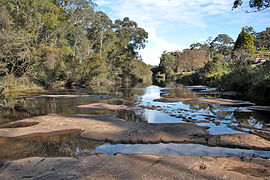Tahmoor, New South Wales
|
Tahmoor New South Wales |
|||||||||||||||
|---|---|---|---|---|---|---|---|---|---|---|---|---|---|---|---|
 |
|||||||||||||||

Bargo River, original crossing place south of Tahmoor
|
|||||||||||||||
| Coordinates | 34°13′27″S 150°35′32″E / 34.22417°S 150.59222°ECoordinates: 34°13′27″S 150°35′32″E / 34.22417°S 150.59222°E | ||||||||||||||
| Population | 5,067 (2016 census) | ||||||||||||||
| Postcode(s) | 2573 | ||||||||||||||
| Location | 90 km (56 mi) SW of Sydney CBD | ||||||||||||||
| LGA(s) | Wollondilly Shire | ||||||||||||||
| Region | Macarthur | ||||||||||||||
| State electorate(s) | Wollondilly | ||||||||||||||
| Federal Division(s) | Hume | ||||||||||||||
|
|||||||||||||||
Tahmoor is a small town in the Macarthur Region of New South Wales, Australia, in Wollondilly Shire.
Originally named Myrtle Creek, it was a farming area on the Great Southern Road, later named the Hume Highway.
When the new Main Southern Railway line opened in 1919, it included a railway station named Tahmoor. This name was contested by a local businessman, who wished to establish a town called Bronzewing Park, but his claim was rejected. The town had recently been named "Tahmoor", a local Aboriginal word for the common bronzewing, (Phaps chalcoptera) a native pigeon often seen in the area.
The Bargo River passes just south of the town; the Bargo River Crossing on the Great South Road was so notoriously difficult for travellers, causing many delays and accidents, that it has even passed into Australian folklore, in the form of the song Stringybark and Greenhide
'If you travel on the road, and chance to stick in Bargo,
To avoid a bad capsize, you must unload your cargo;
For to pull a dray about, I do not see the force on,
The uncleared scrub ('brush') on the opposite bank was known as the Bargo Brush, and was much feared as the haunt of escaped convicts turned bushranger. The road through the Bargo Brush was often all but impassible, as this letter of 1861 attests:
I have just travelled through the Bargo Brush, on the Great Southern Road, but such a road, I unhesitatingly say, never existed in any other civilised or uncivilised part of the world. Dr. Leichhardt met with nothing like it on his overland journey to Port Essington ; nor did Bruce, in his travels in Abyssinia ; nor did Mungo Park, or Dr. Livingstone, in their travels in the interior of Africa.
To give any thing like a graphic description of the state of the road would be impossible. For about twenty miles it is a succession of pits and bogs, and holes of every kind, and in order to prevent the escape of any of the unfortunate travellers into the bush, a ditch has been cut on both sides of the road, so that they are as well secured (although not so safe) as they would be on a treadmill. Every thing that nature and art could do to render a road impassable and dangerous, has been done on the Great Southern Road. Although I have had two days rest since I returned home, I still feel appalled at the dangers I have encountered, and most grateful to Providence for my preservation of both life and limb. My friend and I, who travelled together in a gig determined that we would spare no time or pains in exploring - so as to perform (what appeared to be a miracle) - the getting through this slough of pits and bogs, without breaking a bone of man or beast, or the shafts or springs of our gig. For this purpose one led the horse and the other walked ' before, to explore and take soundings of the pits, bogs, &c.
...
Wikipedia

